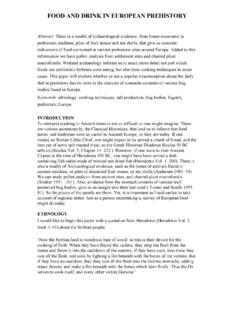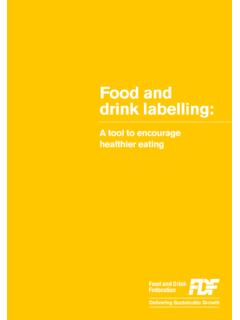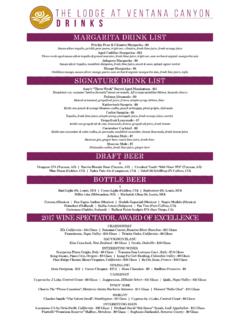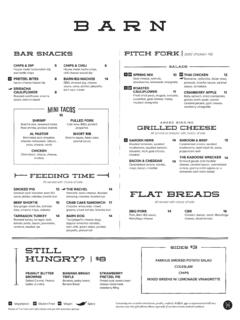Transcription of Current and future development
1 World tea production and tradeCurrent and future developmentWorld tea production and tradeCurrent and future developmentbyKaison Chang - SecretaryFAO Intergovernmental Group on TeaA Subsidiary Body of the FAO Committee on Commodity Problems (CCP)Market and Policy Analyses of Raw Materials, Horticulture and Tropical (RAMHOT) Products TeamTrade and Markets DivisionFOOD AND AGRICULTURE ORGANIZATION OF THE UNITED NATIONSRome, 2015 The designations employed and the presentation of material in this information product do not imply the expression of any opinion whatsoever on the part of the Food and Agriculture Organization of the United Nations (FAO) concerning the legal or development status of any country, territory, city or area or of its authorities, or concerning the delimitation of its frontiers or boundaries.
2 The mention of specific companies or products of manufacturers, whether or not these have been patented, does not imply that these have been endorsed or recommended by FAO in preference to others of a similar nature that are not views expressed in this information product are those of the author(s) and do not necessarily reflect the views or policies of encourages the use, reproduction and dissemination of material in this information product. Except where otherwise indicated, material may be copied, downloaded and printed for private study, research and teaching purposes, or for use in non-commercial products or services, provided that appropriate acknowledgement of FAO as the source and copyright holder is given and that FAO s endorsement of users views, products or services is not implied in any requests for translation and adaptation rights, and for resale and other commercial use rights should be made via or addressed to information products are available on the FAO website ( ) and can be purchased through FAO 2015 Cover photographs: FAO/Joerg Boethling FAO/P.
3 Rocher (Joel Abroad) FAO/Simon Maina FAO/Saul Palma FAO/Giulio Napolitano1 PREAMBLEThis document constitutes an overview of the Current production and trade situation for tea, as well as medium term projections to 2023. Before looking at the specific factors impacting production and trade I would like to provide you with a brief overview of the Intergovernmental Group on Tea: its role and functions, as it is important to understand the context for which I am writing this Intergovernmental Group (IGG) on Tea was established by the Committee on Commodity Problems (CCP) at its Forty-fourth Session in 1969 as the Consultative Committee on Tea. The title of this Body was changed in 1971 to the IGG on Tea and it provides a forum for consultations on and studies of all problems connected with tea.
4 In particular: to conduct a continuing review of short and long term developments in tea production, consumption, trade and prices; to study market structure and the promotion of tea consumption, and to consider international action and prepare proposals for submission to of the Group is open to all Member Nations and Associate Members of the Food and Agriculture Organization that are substantially interested in the production or consumption of, and trade in, tea. To get members more involved with the work of the IGG, and to have more effective analyses of emerging issues that impact the world tea economy, the IGG created working groups with specific terms of reference. Currently, there are seven Working Groups (WGs) of the IGG/Tea: WG on Maximum Residue Levels (MRLs) WG on MRLs in the Brew Tea Trade and Quality WG on Organic Tea WG on Climate Change WG on Smallholders Task Force on StatisticsThe most relevant to this symposium are perhaps the WG on MRLs which was established in 2005 and the WG on MRLs in the Brew which was established in of MRLs in tea is recognized by the IGG on Tea as an issue requiring urgent attention to address concerns on residue levels in tea, their possible effects on consumption and to ensure that tea consumption continues to be safe.
5 The IGG therefore prioritised an initiative where a much closer cooperation among tea producers, importers, traders, boards, associations and other organizations is achieved. It is a well known fact that the complexity in international regulations on pesticides is creating difficulties in legislative compliance in some countries and on the world tea trade. Global harmonization of legislation on MRLs in tea would resolve these difficulties. There is also general recognition that whilst tea is consumed as an infusion, regulations are set on the form in which it is traded, dried Co-chairs of the WG on MRLs in the Brew, China and India, through Professor Chen Zongmao and Dr. Barooah, made submissions to the 43rd and 44th Sessions of the Joint FAO/WHO Food Standards Programme of the Codex Committee on Pesticide Residue (CCPR) that tea, with a few exceptions, was used to make an infusion in water, which is then drunk by consumers.
6 Of primary food safety concern is the amount of agrochemicals in the tea infusion that are taken in via tea drinking, not the amounts of agrochemicals in tea leaf. Following the presentation of a policy document entitled Assessment of MRLs for Pesticides in Tea to the 44th Session of the CCPR in 2012, the CCPR concluded that it ..supported the Current procedure of JMPR in the establishment of MRLs for pesticides in tea and encouraged countries to submit relevant data / information on brewing factors and standard methods to JMPR for consideration in estimation of MRLs for pesticides in tea. The recognition of the brew factor has a great significance as it will pave the way for setting realistic MRLs in tea as risk assessment on dry tea alone would have eliminated a number of useful products.
7 INTRODUCTIONTe a (Camellia sinensis) is the manufactured drink most consumed in the world. Discovered about 2700BC, it is one of the oldest beverages in the world. Today it is available for consumption in six main varieties, based on the oxidization and fermentation technique applied. The tea crop has rather specific agro-climatic requirements that are only available in tropical and sub-tropical climates, while some varieties can tolerate marine climates of British mainland and Washington area of the Unites States. The tea plant needs a hot, moist climate. Its specific requirements are: temperatures ranging from 10-30oC (zone 8 climate or warmer), minimum annual precipitation of 1250 mm, preferably acidic soils, ideally degree slopes and elevations up to 2000 meters.
8 Tea production therefore is geographically limited to a few areas around the world and it is highly sensitive to changes in growing conditions. Importantly, its ideal growing conditions are at high risk and expected to significantly change under climate change. The main determinant for the growth of the global tea economy is demand for the commodity. The analysis of demand for tea carried out by the Secretariat of the IGG on Tea in selected markets indicates that both black and green tea are price elasticities for black tea vary between and , which means that a 10 percent increase in black tea retail prices will lead to a decline in demand for black tea between percent and 8 percent. Estimates for prices elasticities for green tea range between and Similarly, a 10 percent increase in green tea retail prices will lead to a decline in the demand for green tea of percent to about 10 percent.
9 1 As most of the audience at this symposium are scientists, I offer the following note by way of an explanation. In general, the demand for a good is said to be inelastic (or relatively inelastic) when the price elasticity of demand is less than one (in absolute value): that is, changes in price have a relatively small effect on the quantity of the good demanded. The demand for a good is said to be elastic (or relatively elastic) when its price elasticity of demand is greater than one (in absolute value): that is, changes in price have a relatively large effect on the quantity of a good elasticities are almost always factors influence the demand for tea, including the traditional price and income variables, demographics such as age, education, occupation, and cultural background.
10 In addition, health has a great influence on tea consumption which led the IGG to recommend strengthening consumer awareness of the health benefits of tea consumption through an international generic promotion programme. Finally, apart from consumption, other main drivers of international tea prices are trends and changes in per capita consumption, market access, the potential effects of pests and diseases on production, and changing dynamics between retailers, wholesalers and multinationals. HIGHLIGHTSI nternational tea prices, as measured by the FAO Tea Composite price, increased consistently until 2012. In 2013 the average price declined by percent to USD per kg and further declined by percent in 2014 to USD per kg.
















